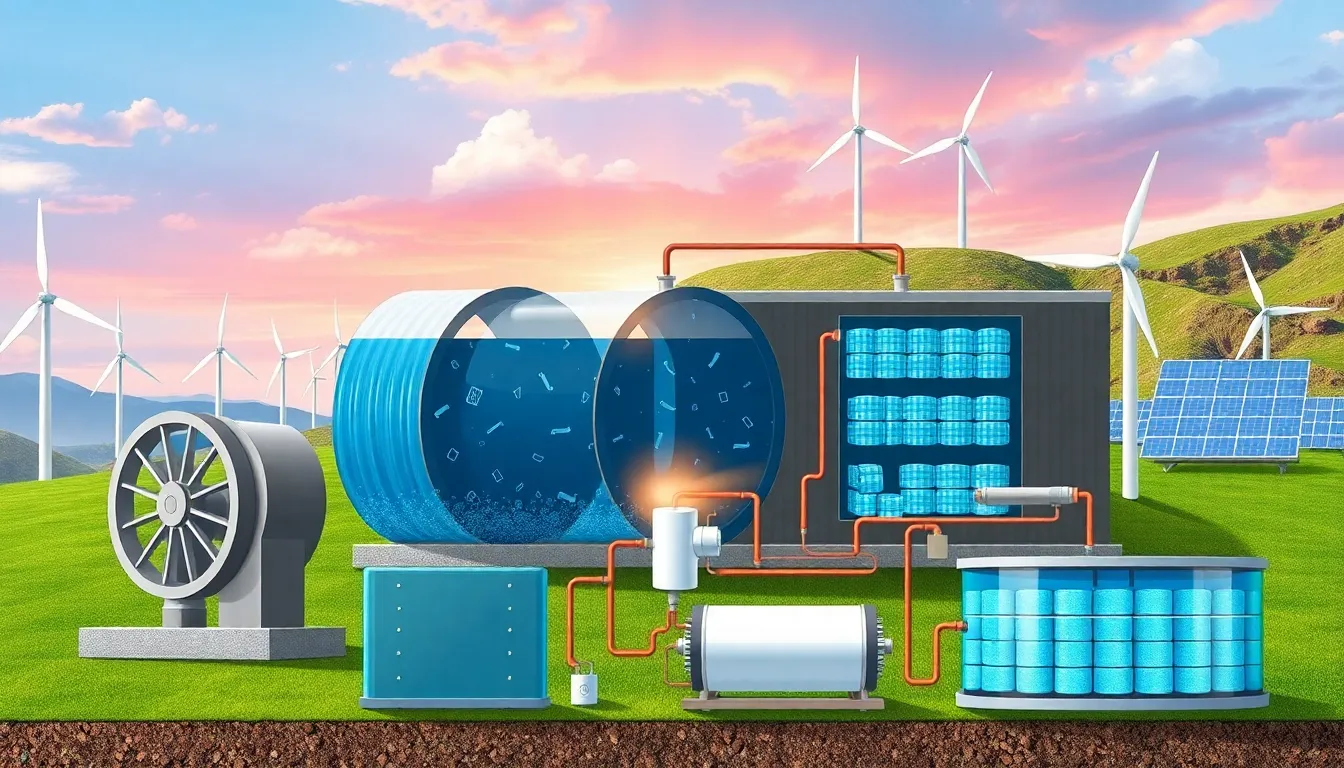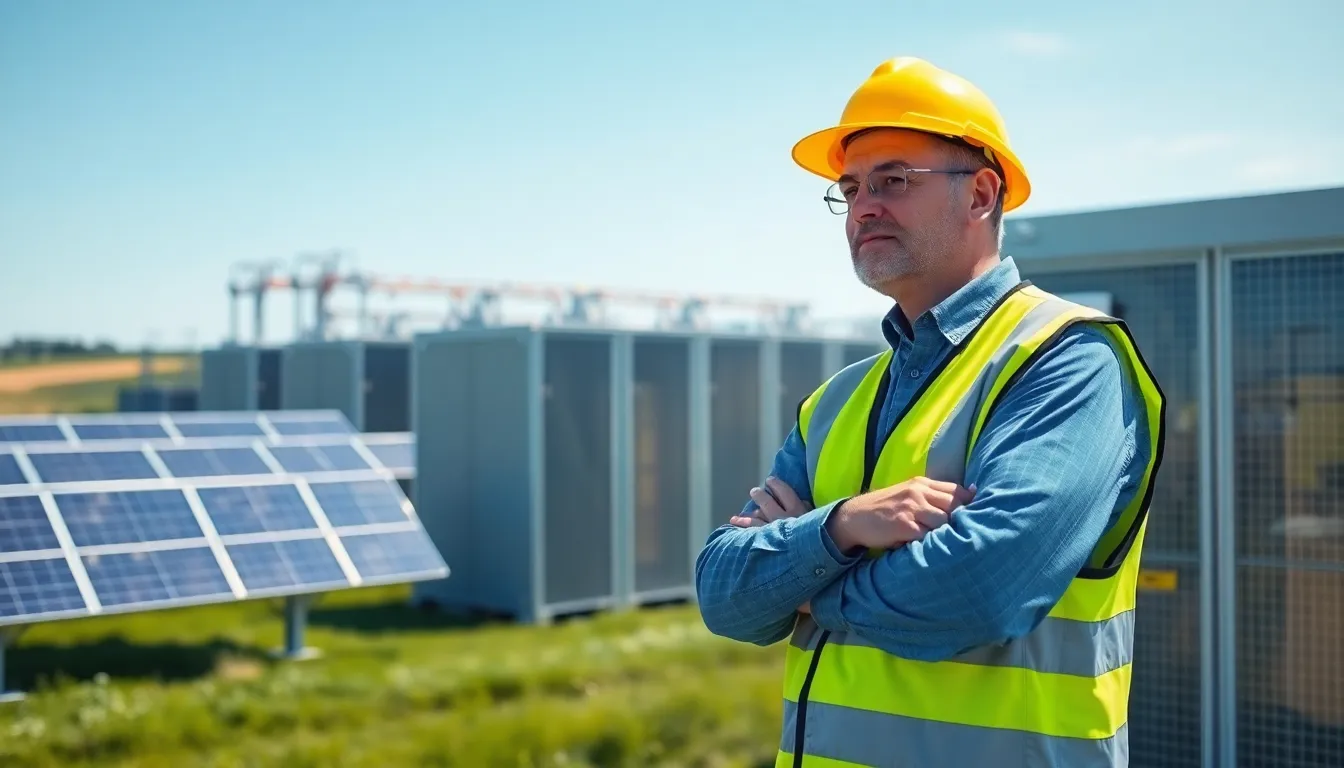In a world where energy demands keep skyrocketing faster than a cat on a laser pointer, green energy storage is stepping up to the plate like a superhero in spandex. It’s not just about harnessing the sun or the wind; it’s about storing that energy for when we really need it—like during a Netflix binge when the power goes out.
Table of Contents
ToggleOverview Of Green Energy Storage
Green energy storage plays a vital role in balancing supply and demand for renewable energy. Storage solutions capture excess energy generated during peak production times, ensuring that power remains available during low production periods. Systems that store energy include batteries, pumped hydro storage, and thermal storage.
Batteries, particularly lithium-ion types, dominate the market due to their efficiency and decreasing costs. They provide rapid response times and scalability, making them suitable for residential and commercial applications. Pumped hydro storage remains the most widely used method, accounting for about 95% of global energy storage capacity. This technique uses water reservoirs to generate electricity when needed.
Thermal storage also contributes significantly to the green energy mix. It allows excess energy to be stored as heat, which can be used later for electricity generation or heating purposes. Technologies in this category include molten salt systems and chilled water storage.
The global energy storage market continues to grow, with an expected capacity increase to over 200 gigawatts by 2025. This growth will facilitate higher integration of renewable energy sources and reduce reliance on fossil fuels. Policymakers and industry leaders emphasize the need for investments in innovative and reliable energy storage technologies to support sustainable development.
Green energy storage not only addresses energy reliability but also enhances grid stability. It enables utilities to manage fluctuations in energy demand, contributing to a more resilient and sustainable energy system. As advancements in technology progress, the focus on improving storage efficiency and reducing costs remains paramount for meeting future energy needs.
Types Of Green Energy Storage Solutions

Green energy storage solutions come in various types, each playing a key role in energy management. The effectiveness of these systems varies based on their technology and application.
Mechanical Storage
Mechanical storage systems utilize physical methods to store energy. Flywheels represent one of these systems, spinning at high speeds to store kinetic energy. Pumped hydro storage, the most widely used, involves moving water between two reservoirs at different elevations. When electricity is abundant, water is pumped uphill; during high demand, water flows back down to generate power. These systems account for about 95% of global energy storage capacity. As a result, they provide reliable large-scale energy solutions.
Chemical Storage
Chemical storage involves converting excess energy into chemical forms. Batteries, particularly lithium-ion batteries, excel in this category. These batteries store energy in a chemical reaction, allowing for quick release when needed. Hydrogen fuel cells also fall within this category, converting hydrogen into electricity through various chemical processes. Both technologies have seen significant advancements, reducing costs and improving efficiency. Such innovations enable better integration of renewable energy sources into the grid.
Thermal Storage
Thermal storage systems capture excess energy as heat. Concentrated solar power systems use this method, storing heat generated during sunny periods to produce electricity later. In addition, water tanks and molten salt can serve as effective thermal storage mediums. These systems allow utilities to manage load and enhance energy efficiency. By storing energy as heat, they contribute to a balanced energy supply, ready for periods of high demand. This approach supports the overall stability of the energy grid.
Benefits Of Green Energy Storage
Green energy storage offers numerous advantages, significantly impacting environmental sustainability and economic growth.
Environmental Impact
Reducing greenhouse gas emissions ranks as one of the primary benefits. Utilizing renewable energy sources minimizes reliance on fossil fuels, leading to cleaner air and a lower carbon footprint. Energy storage systems enhance the overall efficiency of renewable sources. They allow for better integration of wind and solar power into the grid. Storing excess energy during peak production periods reduces waste and conserves valuable resources. Additionally, green energy storage facilities contribute to habitat preservation by decreasing the need for new fossil fuel extraction sites. These systems play a crucial role in combating climate change, supporting long-term ecological balance.
Economic Advantages
Economic benefits also emerge from green energy storage. Job creation happens through the manufacturing and installation of storage technologies. Forecasts suggest that the global energy storage market may exceed 200 gigawatts by 2025, driving demand for skilled workers. Lower energy costs result from optimized energy usage and reduced dependence on expensive fossil fuel sources. Consumers and businesses alike experience savings as stored energy becomes available during high-demand periods, avoiding peak pricing. Green energy storage fosters energy independence, encouraging local economies and stabilizing energy prices. Innovation in storage technologies enables competitive markets, promoting further developments in sustainable energy solutions.
Challenges And Limitations
Green energy storage faces numerous challenges that impact its growth and implementation. These obstacles range from technological barriers to policy and regulatory issues.
Technological Barriers
Technological advancements lag behind the growing demand for efficient energy storage solutions. Limited battery lifespan affects long-term reliability, hindering widespread adoption. High costs associated with certain technologies restrict access to the vast potential of energy storage systems. Innovations are necessary to enhance battery capacities and reduce degradation rates. Scalability remains a concern for emerging technologies, as many solutions are not yet viable for large-scale applications.
Policy and Regulatory Issues
Regulatory frameworks struggle to keep pace with rapid advancements in energy storage technologies. Lack of clear policies creates uncertainty for investors and developers, slowing down project initiation. Streamlined permitting processes are essential for overcoming bureaucratic hurdles. Incentives for energy storage deployment remain inconsistent among different regions and states. Policymakers must enhance collaboration to establish standardized regulations that support growth in the energy storage sector. Such measures could facilitate the integration of renewable energy sources into existing grids.
Future Of Green Energy Storage
Growth in green energy storage technologies appears promising. By 2025, the global energy storage capacity is projected to exceed 200 gigawatts. This expansion will facilitate greater integration of renewable energy sources, significantly reducing reliance on fossil fuels. Innovative technologies continue to emerge, enhancing both efficiency and affordability.
Lithium-ion batteries dominate the market due to their efficiency and declining costs. Many companies are researching alternative battery technologies, aiming to improve lifespan and performance. Another development involves hydrogen fuel cells, capable of transforming excess energy into usable fuel. Such advancements allow for greater energy flexibility and grid stability.
Pumped hydro storage has historically accounted for approximately 95 percent of global energy storage capacity. Expanding this technology could lead to more sustainable solutions. Additionally, thermal storage systems capture energy as heat, which can later supply power during peak demand times. These systems utilize various mediums, including molten salt and water.
Challenges do remain. Limited battery lifespan and high manufacturing costs pose significant barriers. Industry leaders advocate for collaboration among policymakers to clarify regulations. Establishing standardized guidelines could drive investment in energy storage technologies, enabling wider adoption.
Sustainability and economic development intersect within this sector. Economically, green energy storage creates jobs in manufacturing and installation. As the market grows, the demand for skilled workers will increase, promoting innovation and sustainable energy solutions. This synergy between environmental sustainability and economic growth highlights the critical role of energy storage in shaping the future energy landscape.
The future of energy storage is bright and essential for a sustainable world. As green energy technologies continue to evolve the ability to store and manage renewable energy will play a pivotal role in reducing carbon emissions and enhancing grid stability. Investments in innovative storage solutions will not only support the transition away from fossil fuels but also create economic opportunities and jobs in the renewable sector.
Overcoming current challenges through collaboration among industry leaders and policymakers is crucial. By establishing clear regulations and promoting advancements in technology the energy storage market can thrive. Embracing these solutions will lead to a more resilient energy system that meets the demands of modern society while protecting the environment for future generations.






